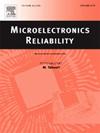研究轨道上锡须的特性和生长情况
IF 1.6
4区 工程技术
Q3 ENGINEERING, ELECTRICAL & ELECTRONIC
引用次数: 0
摘要
为了证实锡基无铅部件在卫星上的适用性,我们验证了锡须在轨道上的生长特性。结果表明,在轨样品上生成的锡须生长得细、长、直。在轨样品中观察到的最长锡须约为 767 微米。在轨样品中,锡须的侧面有细小的条纹环。这一特征是热循环产生的锡须。此外,轨道上的锡须和地面上的锡须在空气中的生长特征也有所不同。然而,轨道上和地面真空中的锡须表现出相同的生长特征。这些结果表明,热循环和真空(即无氧)对轨道上锡晶须的生长和形状有很大影响。横截面扫描电子显微镜显示,在轨样品上,镀锡晶粒排列整齐,沿镀锡晶界没有发现深槽;而在地面空气中,镀锡晶界开裂,与相邻晶粒的界面分离。因此,由于镀锡晶粒排列整齐,锡原子在轨道上更容易扩散;在轨道上产生了许多很长的锡须。本文章由计算机程序翻译,如有差异,请以英文原文为准。
Study of the characteristics and growth of tin whiskers in orbit
To confirm the applicability of tin-based lead-free parts in satellites, we validated the growth characteristics of tin whiskers in orbit. The result was that the tin whiskers generated on the in-orbit samples grew thin, long, and straight. The longest tin whisker observed in the in-orbit samples was approximately 767 μm. There were fine striation rings on the side face of the tin whisker in the in-orbit samples. This characteristic is the tin whiskers generated by thermal cycling. In addition, the growth characteristics of tin whiskers in orbit and on the ground in air differed. However, tin whiskers in orbit and on the ground in a vacuum exhibited the same growth characteristics. These results indicate that thermal cycling and vacuum (i.e., no oxygen) significantly influence the growth and shape of tin whiskers in orbit. Cross-sectional scanning electron microscope showed that on the in-orbit samples, the tin plating grains were neatly arranged, and no deep grooves along the tin plating grain boundaries were identified; whereas, on the ground in air, the tin plating grain boundaries were cracked, and the interfaces with adjacent grains were separated. Therefore, tin atoms diffused more easily in orbit because of the fine alignment of the tin plating grains; many very long tin whiskers were generated in orbit.
求助全文
通过发布文献求助,成功后即可免费获取论文全文。
去求助
来源期刊

Microelectronics Reliability
工程技术-工程:电子与电气
CiteScore
3.30
自引率
12.50%
发文量
342
审稿时长
68 days
期刊介绍:
Microelectronics Reliability, is dedicated to disseminating the latest research results and related information on the reliability of microelectronic devices, circuits and systems, from materials, process and manufacturing, to design, testing and operation. The coverage of the journal includes the following topics: measurement, understanding and analysis; evaluation and prediction; modelling and simulation; methodologies and mitigation. Papers which combine reliability with other important areas of microelectronics engineering, such as design, fabrication, integration, testing, and field operation will also be welcome, and practical papers reporting case studies in the field and specific application domains are particularly encouraged.
Most accepted papers will be published as Research Papers, describing significant advances and completed work. Papers reviewing important developing topics of general interest may be accepted for publication as Review Papers. Urgent communications of a more preliminary nature and short reports on completed practical work of current interest may be considered for publication as Research Notes. All contributions are subject to peer review by leading experts in the field.
 求助内容:
求助内容: 应助结果提醒方式:
应助结果提醒方式:


